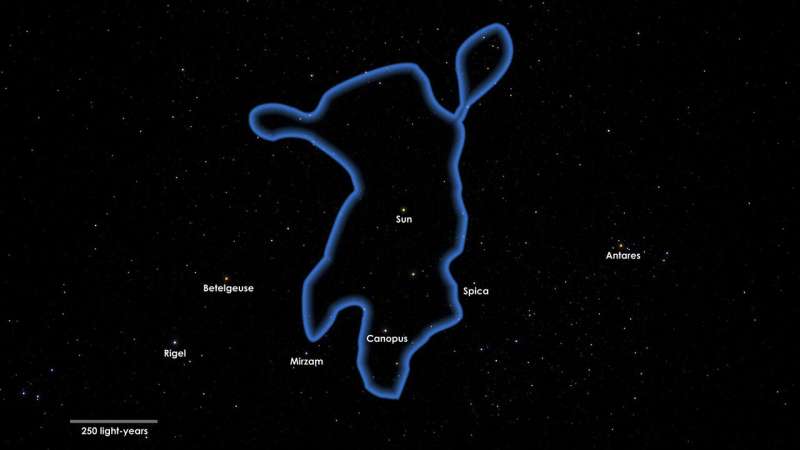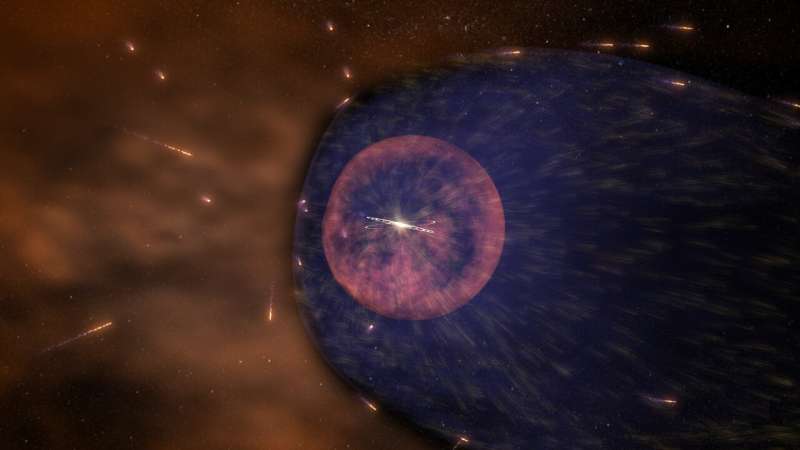The mission, called the Spatial Heterodyne Interferometric Emission Line Dynamics Spectrometer, or SHIELDS, will have its first opportunity to launch aboard a suborbital rocket from the White Sands Missile Range in New Mexico on April 19, 2021.
Our entire solar system is adrift in a cluster of clouds, an area cleared by ancient supernova blasts. Astronomers call this region the Local Bubble, an oblong plot of space about 300 light-years long within the spiraling Orion arm of our Milky Way galaxy. It contains hundreds of stars, including our own Sun.
We fare this interstellar sea in our trusty vessel, the heliosphere, a much smaller (though still gigantic) magnetic bubble blown up by the Sun. As we orbit the Sun, the solar system itself, encased in the heliosphere, hurtles through the Local Bubble at about 52,000 miles per hour (23 kilometers per second). Interstellar particles pelt the nose of our heliosphere like rain against a windshield.
Our heliosphere is more like a rubber raft than a wooden sailboat: Its surroundings mold its shape. It compresses at points of pressure, expands where it gives way. Exactly how and where our heliosphere's lining deforms gives us clues about the nature of the interstellar space outside it. This boundary—and any deformities in it—are what Walt Harris, principal investigator for the SHIELDS mission, is after.
SHIELDS is a telescope that will launch aboard a sounding rocket, a small vehicle that flies to space for a few minutes of observing time before falling back to Earth. Harris' team launched an earlier iteration of the telescope as part of the HYPE mission in 2014, and after modifying the design, they're ready to launch again.
SHIELDS will measure light from a special population of hydrogen atoms originally from interstellar space. These atoms are neutral, with a balanced number of protons and electrons. Neutral atoms can cross magnetic field lines, so they seep through the heliopause and into our solar system nearly unfazed—but not completely.

The small effects of this boundary crossing are key to SHIELDS's technique. Charged particles flow around the heliopause, forming a barrier. Neutral particles from interstellar space must pass through this gauntlet, which alters their paths. SHIELDS was designed to reconstruct the trajectories of the neutral particles to determine where they came from and what they saw along the way.
A few minutes after launch, SHIELDS will reach its peak altitude of about 186 miles (300 kilometers) from the ground, far above the absorbing effect of Earth's atmosphere. Pointing its telescope towards the nose of the heliosphere, it will detect light from arriving hydrogen atoms. Measuring how that light's wavelength stretches or contracts reveals the particles' speed. All told, SHIELDS will produce a map to reconstruct the shape and varying density of matter at the heliopause.
The data, Harris hopes, will help answer tantalizing questions about what interstellar space is like.
For instance, astronomers think the Local Bubble as a whole is about 1/10th as dense as most of the rest of the galaxy's main disk. But we don't know the details—for instance, is matter in the Local Bubble is distributed evenly, or bunched up in dense pockets surrounded by nothingness?
"There's a lot of uncertainty about the fine structure of the interstellar medium—our maps are kind of crude," Harris said. "We know the general outlines of these clouds, but we don't know what's happening inside them."
Astronomers also don't know much about the galaxy's magnetic field. But it should leave a mark on our heliosphere that SHIELDS can detect, compressing the heliopause in a specific way based on its strength and orientation.
Finally, learning what our current plot of interstellar space is like could be a helpful guide for the (distant) future. Our solar system is just passing through our current patch of space. In some 50,000 years, we'll be on our way out of the Local Bubble and on to who knows what.
"We don't really know what that other cloud is like, and we don't know what happens when you cross a boundary into that cloud," Harris said. "There's a lot of interest in understanding what we're likely to experience as our solar system makes that transition."
Not that our solar system hasn't done it before. Over the last four billion years, Harris explains, Earth has passed through a variety of interstellar environments. It's just that now we're around, with the scientific tools to document it.
"We're just trying to understand our place in the galaxy, and where we're headed in the future," Harris said.
Explore further



